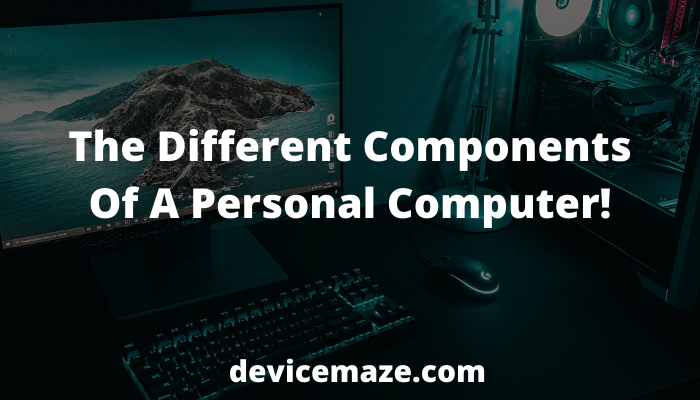Going over the components of a PC and its functions will assist you in comprehending all the vital parts that make up a PC. It is an excellent place to begin if you desire to learn about PCs. Not just is it a great entry point, but it is also something great to know for curiosity’s sake. Knowing what the component is, is good, but we’ll explain each component’s function, which will provide you with a firmer understanding of them.
Components Of A PC:
Whether it is a gaming computer or a home computer, the five main parts that make up a typical present-day PC comprise:
- A motherboard
- A CPU
- A GPU (Graphics Processing Unit), also recognized as the video card
- RAM (Random Access Memory), also recognized as volatile memory
- Storage: HDD (Hard Disk Drive) or SSD (Solid State Drive)
In terms of construction, all of such main parts are connected to your motherboard and then put into a protective PC case, resembling the polished, clean look the majority of us are used to seeing. Sure, the majority of PCs have their own distinct design and diverse manufacturers of hardware installed, but the parts listed here are standard across all PCs.
Important: A note before we get into the details, I’m listing the diverse parts of a PC. It’s by no means intended to be a call to disassemble the PC, nor is it a set of directions to do so. Without the proper understanding, you can severely damage the PC, and highly, doing that is unsafe.
Motherboard:
All PC parts communicate through a circuit board known as a motherboard, as was stated earlier. Think of a board as the glue that can hold everything else together. It is a thin plate that can hold the memory, CPU, connectors for the optical drives and hard drive, expansion cards for controlling the audio and video, and connections to the PC’s ports (like USB ports). The motherboard can connect indirectly or directly to each component of the PC.
RAM (Random Access Memory):
It’s a storage device that can offer fast write and read access. RAM is also volatile, which denotes that it can misplace all the saved information when power is lost. The RAM can keep information prepared for your CPU to process. The RAM speed is a huge contributor to your overall PC speed.
It can plug directly into the long slot with contacts on either side. It, too, comes with the clock speed, just like your processor. So, it can also easily be overclocked for delivering better performance beyond the intended spec.
GPU (Graphics Processing Unit):
It is not uncommon to hear gamers get obsessed over the latest graphics card, as such graphic cards make it possible for PCs to make high-end visuals like the ones found in a lot of diverse video games.
In addition to the video games, though, great graphics cards also prove to be helpful for the users who depend on images for executing their craft, such as 3D modelers utilizing the resource-intensive programs. The Graphics cards frequently communicate with your display monitor directly, meaning a 1,000 dollars graphics card would not be of much use if there is not a high-end monitor connected to it.
CPU (Central Processing Unit):
The CPU is frequently known as the brain of a PC, thanks to the direct plug connection to the board and communication with all of the other parts of the PC. Whenever you write some code (in C++, Java, Python, or any other programming language), it is broken down into the assembly language, which’s a language that a processor can comprehend. It fetches, deciphers, and executes such directions. And that is where a CPU comes in; all the processes a PC can handle are actually taken care of by your CPU.
Storage:
All PCs require somewhere to save their information. The modern PCs either make use of an SSD (Solid State Drive) or HDD (Hard Disk Drive). Hard Disk Drives are made of the actual disk onto which information is saved.
The disk is read by the mechanical arm. (Hard Disk Drives are cheaper than Solid State Drives but are gradually becoming increasingly obsolete.) Solid State Drives (think SIM cards) have no moving components and are faster than the hard drive because no time is invested waiting for the mechanical arm to locate information on the physical location on your disk.
